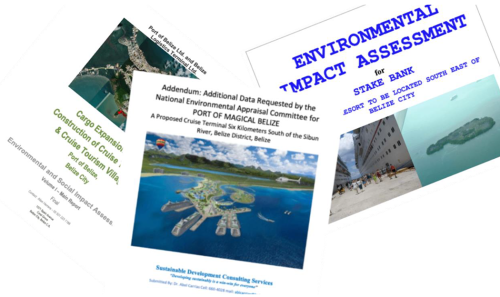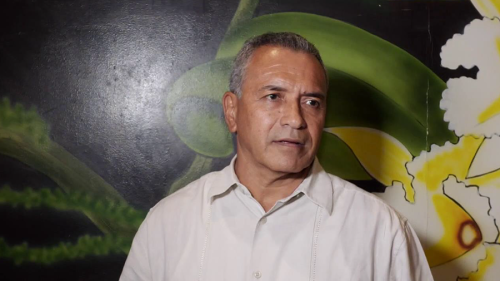by Marco Lopez
The EIA process is designed to safeguard the environment from potentially dangerous developments, and in turn, the process should contribute to a strong blue economy for Belize. Despite the nation’s environmental agencies’ authority to reject development proposals deemed environmentally unsustainable, these decisions are often held hostage by legal challenges, as in the case of Waterloo Investment Holdings Limited (Waterloo). With no measure within the process to take meaningful account of public opinion, the voices of coastal communities directly impacted by these developments typically go unheard, with consultations executed as a mere checklist requirement.
A notice of dispute under the UK Belize Bilateral Investment Treaty (BIT) was sent to Prime Minister Hon. John Briceño on April 3, 2023, by Waterloo Investment Holdings Limited (Waterloo). The company is owned by UK/Belizean businessman Lord Michael Ashcroft and is one of three entities proposing to develop a cruise port off the coast of Belize City. Waterloo’s proposal has been denied approval twice by the National Environmental Appraisal Committee (NEAC) and the Department of the Environment (DOE).
Significant impact on Belize’s marine environment and inadequate measures to mitigate these effects are the key reasons for the rejection of the proposal’s Environmental Impact Assessment (EIA). An appeal process has been derailed by its attorneys after the Minister of Sustainable Development, Hon. Orlando Habet, initiated changes to address an appearance of bias in the composition of the tribunal.
Cruise Port proposals
Waterloo has initiated local and international proceedings to keep the prospects for its development alive. Locally, they are suing Minister Habet for the changes he authorized to the NEAC’s appeal tribunal. Internationally, they are claiming losses to shareholders under the previously mentioned investment treaty. In both cases, the company is claiming the environmental approval process they have had to undergo was unfair, and that the environmental oversight bodies were biased in their decision. “Especially the applications made by two greenfield developments: Port of Magical Belize and Stake Bank,” Waterloo’s notice of claim states.
Stake Bank, owned by the Feinstein Company, has received environmental clearance and is the only cruise port that has begun construction. It is nearing completion. This project, while approved by the current government, has been a source of some controversy due to the potential impact of its proposed causeway that would disrupt the activities of marine life living and moving through the Belize City coast. Additionally, the authenticity of EIA clearance specifically for a proposed causeway that is part of the project remains unclear after the DoE initially failed to provide documentation to the media verifying it had received clearance. There is still no clear indication from the DOE confirming if the full causeway has been approved.
Port of Magical Belize is being proposed by Portico Enterprise Limited. They have received environmental clearance and have signed a partnership agreement with the international cruise company Royal Caribbean Group. However, on the ground, the High Court has allowed a judicial review into its environmental clearance, and a controversial Definitive Agreement signed by a former Minister of Government in favor of the company has been fiercely rejected.
Belize’s Blue Economy and the Cruise Port Boom
With three developments proposed to operate within an about 8-mile radius of each other, the public and experts have pondered the economic feasibility and the cumulative environmental impact of all three ports on our priceless marine space. Moreover, Belize along with the Nature Conservancy has put together a loan agreement to pay off its foreign debt under a ‘Blue Bond’ instrument, promising to protect 30% of its ocean by implementing key measures to build a sustainable blue economy.
Unsustainable development has been the primary cause of the loss of marine ecosystems like mangroves, seagrass, and even coral. In Belize, our Ministry of Blue Economy has set a roadmap for building and sustaining our marine space. Belize’s first Maritime Economic Plan was also revealed, all in hopes of spring-boarding blue economy development in Belize. The blue economy, as defined by the United Nations, “comprises a range of economic sectors and related policies that together determine whether the use of ocean resources is sustainable.”
Origins of the EIA Process
In 1989 the PUP government created the Ministry of Tourism and Environment – a fulfillment of the new George Price government manifesto promise. Attorney Glenn Godfrey was the first minister, and oversaw the creation of the Environmental Protection Act 1992 (EPA), establishing the Department of the Environment. In 1995 the EPA was revised, and stronger environmental regulations were added. This included the Environmental Impact Assessment process.
This also gave birth to the NEAC and created measures to determine whether or not a project needed an EIA and its contents. These laws and the process have been revised several times, most notably, recently, to remove the ministerial powers to reject a development proposal at appeal.
This was changed to allow the formation of the three-person appeal tribunal to hear the petition of developers whose projects are rejected.
The decision of this appeals tribunal is the last legislated step in the EIA process that a developer can take, and the body has the authority to reverse the NEAC’s and DOE’s decisions and approve projects, or to uphold the decisions and reject them.

Front Page of the cruise port EIA documents
End in Sight…?
The outcome of Waterloo’s cases against the country will set a new precedent in the environmental clearance process in Belize. The country’s autonomy to accept or reject the developments perceived as unsustainable remains, in essence, a question within the courts. The 1982 BIT treaty which obliges Belize to protect UK investors is a vestige of colonialism that ensures investments of UK nationals are protected, and may lead to significant economic losses for the country if Waterloo’s claim for a monetary award under international arbitration is upheld.
While these external forces create holes in the EIA process, internal shortfalls also contribute to the gaps in the vital procedure. A lack of meaningful public consultation and participation, mandated by the Escazú treaty, which Belize has ratified, is still lacking. The practice of EIA development is not regulated, and has long fallen victim to a “copy and paste” culture in the creation of EIA documents. Besides this, the socio-economic impacts of developments are not fully assessed and taken into consideration during the process.
Minister Habet has stated that the DOE and Ministry of Sustainable Development have already begun revising the EIA process. Under clause three of the Blue Bond’s Conservation Funding Agreement, the country has committed to finalizing revisions to the EIA regulations and will include revisions to better support our marine space.

Hon. Orlando Habet – Minister of Sustainable Development, Belize (Photo by Edson Dubon)
However, while “these commitments are not linked to any Milestones” (and, as a result, failure to meet these commitments would not result in an obligation to make any Conservation Event Payments or subject the country to any penalties of any kind), “Belize acknowledges its good faith intention to comply with these undertakings within the parameters of its Constitution,” the Conservation Commitments state.

Mangroves off the coast of Belize City (By Marco Lopez)
As human rights lawyer Leslie Mendez put it, “Putting public pressure to sign on to these agreements is important … there’s great potential of what you can do with those agreements, but you’re still gonna have to work, you’re still gonna have to organize, you’re still gonna have to mobilize.”
Therefore, whether the Blue Bond or Escazú will have any teeth to transform the execution of the EIA process remains to be seen, and appears to depend largely on how Belizeans mobilize to use them.
In a video companion to this article, André Habet talks at length with EIA stakeholders about these issues and others. View the story on Plus TV.
This story was produced with the support of Internews’ Earth Journalism Network.

